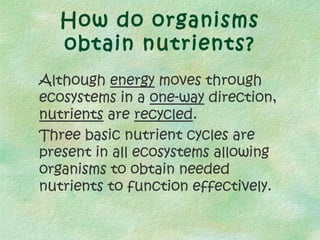
Nutrient cycles presentation
- 1. How do organisms obtain nutrients? Although energy moves through ecosystems in a one-way direction, nutrients are recycled. Three basic nutrient cycles are present in all ecosystems allowing organisms to obtain needed nutrients to function effectively.
- 2. Water Cycle Driving force is the sun. Consists of the alternation between evaporation and condensation. Most water returned to the atmosphere comes from evaporation from the oceans.
- 3. Water Cycle
- 4. Water Cycle Terminology Water vapor- gaseous form of water in atmosphere Evaporation- liquid water from bodies of water becomes gas returned to atmosphere. Transpiration- loss of water by land plants Condensation- process which water molecules gather in atmosphere “change from gas to liquid” when cooled. Precipitation- water falls from atmosphere to ground (rain, snow, sleet, or hail)
- 5. Why is the water cycle important? Water is the most important nonliving (abiotic) component of an ecosystem. Water essentially determines what organisms we find in an ecosystem. What is the major difference between the tropical rainforest and the desert? Why?
- 6. Carbon Cycle Carbon cycles between the living organisms and the non-living components of ecosystem. Carbon exists in the atmosphere as carbon dioxide (CO2) Why do living things need carbon?
- 7. Carbon Cycle
- 8. Carbon Cycle Terminology Photosynthesis- process where sunlight, CO2 and H2O is used to make food Respiration- process by which animals take in O2 given off by plants and give off CO2 ***THE OPPOSITE OF PHOTOSYNTHESIS! Fossil fuels- formed by pressure applied to dead organisms that are buried in sediment. They are carbon and release CO2 when burned. Combustion- burning of fossil fuels
- 9. Why is the carbon cycle important? Energy for living organisms (carbohydrates). ***Humans in the United States are altering this cycle. Burning of too many fossil fuels is releasing extra CO2 into the atmosphere creating “global warming” due to increased greenhouse effect.
- 10. Nitrogen Cycle The atmosphere contains 80% nitrogen gas (N2). However, this nitrogen can not be used by most living things. Bacteria are the only organisms that are use nitrogen directly from the environment. They can fix nitrogen for plants to use
- 11. Nitrogen Cycle
- 12. Nitrogen Cycle Terminology Nitrogen fixation- nitrogen gas in atmosphere to ammonia (bacteria in soil, lightning) Nitrification- ammonia to nitrate (bacteria in soil) Assimilation- absorption of ammonia and nitrate by plants Ammonification- break down of dead organisms returns nitrogen to soil (bacteria and fungi) as ammonia. Denitrification- conversion of ammonia back to nitrogen gas (decomposers).
- 13. Why is the nitrogen cycle important? Why is nitrogen important to living things? How do plants obtain nitrogen? Why are bacteria SO important to the nitrogen cycle? How do we obtain nitrogen?